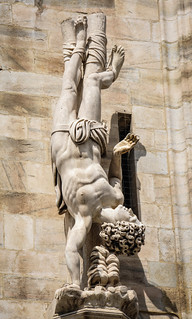We make a living by what we get, but we make a life by what we give.
Tell me a story and I’ll tell you who you are ... Travelling to Prague to see Kafka improves pattern-finding! In fact, any absurd or uncanny literature may be able to do this, a recent study from UC Santa Barbara suggests. According to the study, patients who read a nonsensical story performed better on grammatical pattern-learning tasks than did patients who read a similar story with a logical structure. One theory is that being temporarily immersed in a world of unfamiliar nonsense makes the brain more “motivated to find structure” in its surroundings. Kafka's The Country Doctor
And old postcard and old bohemian souverin made me realise that musings about the second oldest profession and mobile bills tend to be less and less tolerated. It could be the makings of an absurdist play ... In Woody Allen’s latest production, To Rome With Love, half the film’s dialogue is in Italian and in Prague Media Dragons will have a perfect opportunity to take advantage of the master of neurotic dialogue as the film will be WITH ENGLISH SUBTITLES. After the movie rivers of disconnected long service thoughts will be flowing in the The Monastery of Břevnov - ;-)
If Cold War is remembered at all these days, it is always for the wrong reasons ... “In a market society, you rent people; in a slave society, you buy them. So therefore slave societies are more moral than market societies. Well, I’ve never heard an answer to that, and I don’t think that there is an answer. But it’s rejected as morally repugnant – correctly – without following out the implications, that renting people is an atrocity. If you follow out that thought, slave owners are right: renting people is indeed a moral atrocity. There are many similarities between modern wage slavery and chattel slavery
When I was very young, I used to play for hours in an old stone barn at the back of our garden in Dorset, 150 miles west of London. It is one of the first rooms I can recall with clarity. I loved its smells and dusty shelves filled with old clay flowerpots and spiders’ webs. I can remember that shed intensely, although I have not been in it for more than 30 years. What is it about our memory that it is intertwined so strongly with recollections of places, smells, rooms, I wonder – as much, or in fact more so, than people? In the 1950s my grandparents built a house overlooking the Beaulieu River in Hampshire. Having bought their plot of land, they couldn’t afford much for the house; so it was a fairly simple wooden bungalow, with shingle walls and wide glass walls overlooking the woods and the river. I used to love staying there.Vrbov of Vivid Memories-
People like living in protected, historic places that make their properties more valuable. Good companies want to locate close to conservation areas because their employees want to live there
Listening to silence. John Cage knew that nothing is not nothing. It is always something – a provocation, a joke, an invitation to pay attention...
It’s summer time, which means it’s time for the annual pilgrimage to Venice or west Bohemian spa town in the hopes of discovering something brilliant. At the age of 69, the Venice film festival needed a facelift. Venice Films;At the Rebbibia high-security prison in Rome, theater director Fabio Cavalli has decided to use inmates for his next production of William Shakespeare’s Julius Caesar, a play about betrayal and bloody murder. Karlove Vary; Prague - Fresh Film Fest 2012
A bit off-topic - For a while, Prague was even home to Semyon Mogilevich, the notorious Ukrainian-born Russian criminal who is a fixture on the FBI's "most wanted" list. However, the Russians' very visibility was also their weakness. They attracted far too much police attention and the enmity of local gangs.The return of the Russian gangsters
Writing about writers; an atrocity ignored the most influential book in English In the midst of life we are in death; Authors are being exposed for fabricating glowing reviews for their own books. But why risk ridicule for the sake of a good writeup? Sock puppetry and fake reviews: publish and be damned ; When is a book more than a book? When it’s wielded as a weapon, or used to signify wealth, status, taste. Or to wrap food, wipe bottoms. Books Before and After
Lewis Carroll and Jorge Luis Borges imagined it, and now Google might make it” real: a one-to-one scale map of the world. Useful or creepy? “The map is mapping us How Google and Apple's digital mapping is mapping us; Apple makes tons of money selling gadgets, and everything else is an afterthought. It’s the other way around at Amazon, and Jeff Bezos thinks that’s worth bragging about Amazon: We’re No Apple; Group said it found over 12m Apple IDs on agent's computer, but FBI says it has no knowledge of any data breach AntiSec: Hackers embarrass Apple with data leak
CODA: The job of a model, while not without its great perks, involves a talent for acting, extreme patience and the hide of a rhino when it comes to criticism Real Women - Brigitte - no models ; There are many branches of philanthropy, but I’m interested in tracing that smile in historic buildings that warms implacable hearts. The needs of our ailing cultural heritage face stiff competition from education, medicine and social hardship, although they can interrelate: finding the support to restore a beautiful library in an orphanage would be a doddle. But who loves architecture for its own qualities, and how does a business brain turn into a sugar daddy? Real Real Estate
